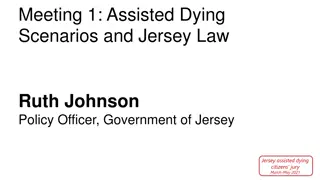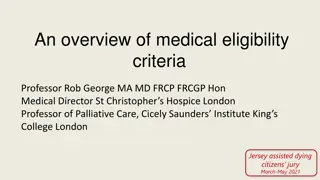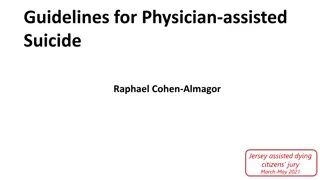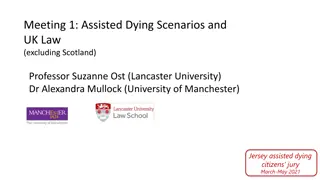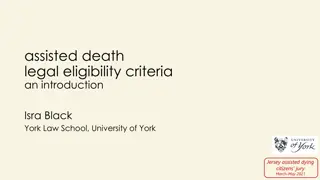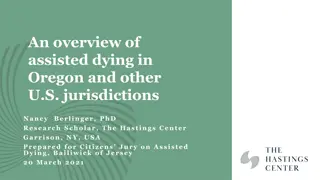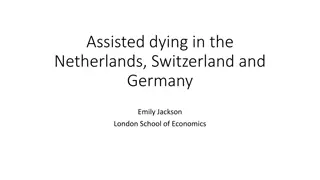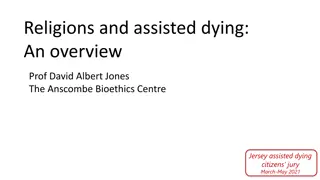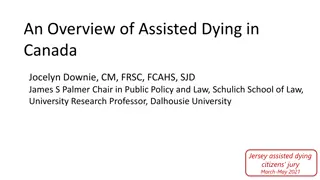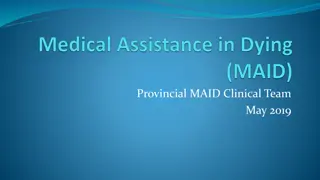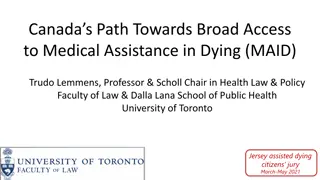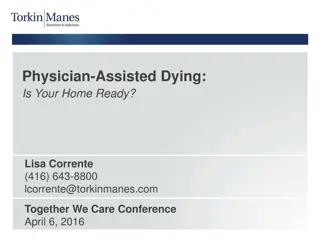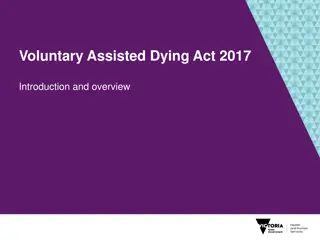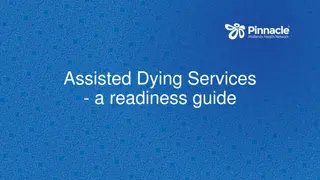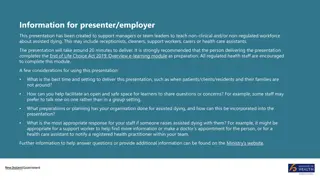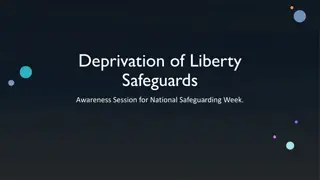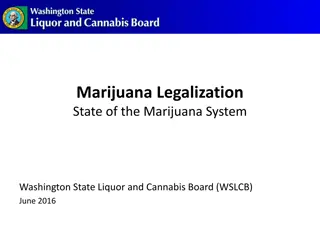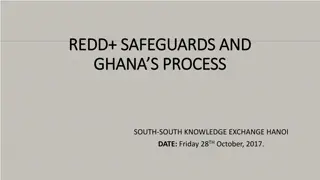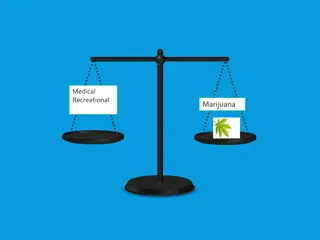Assisted Dying in Belgium: Legalization, Criteria, and Safeguards
Belgium's journey to legalizing assisted dying, including the key eligibility criteria under the euthanasia law, introduction of palliative care legislation, and the importance of safeguards and processes. Positive and negative experiences, along with key data, shed light on the situation in Belgium.
Download Presentation

Please find below an Image/Link to download the presentation.
The content on the website is provided AS IS for your information and personal use only. It may not be sold, licensed, or shared on other websites without obtaining consent from the author. Download presentation by click this link. If you encounter any issues during the download, it is possible that the publisher has removed the file from their server.
E N D
Presentation Transcript
An overview of assisted dying in Belgium for the Jersey Assisted Dying Citizens Jury Sigrid Sterckx March / April 2021 1
Overview I. The journey to legalisation II. The key eligibility criteria for euthanasia in Belgium (in Belgium assisted dying = euthanasia) III. The key safeguards and processes IV. Key data to illustrate the situation in Belgium V. Positive and negative experiences + unintended consequences 2
I. The journey to legalisation The element that played the most important role in the adoption of a euthanasia law in Belgium was an in-depth empirical study demonstrating that in 1998 intentional life ending by physicians at the request of the patient accounted for 1.3% of all deaths in Flanders, and intentional life ending by physicians withoutrequest accounted for 3.2% [NB in NL 1995: resp. 2.4% and 0.7%; in Australia 1995: 1.7% and 3.5%] Deliens L et al. 2000. End-of-life decisions in medical practice in Flanders, Belgium: A nationwide survey . Lancet 356: 1806-11. 3
I. The journey to legalisation Belgium simultaneously introduced a euthanasia law, after three years of debate in Parliament (28 May 2002) and a law on palliative care (14 June 2002) (idem Luxembourg in 2009) Belgian Act regarding palliative care, Art. 2: Every patient has a right to palliative care at the end of life. Equal access to such care for all incurably ill patients must be guaranteed through a sufficiently broad supply of palliative care services and the criteria of reimbursement of such care by the social security system. 4
II. Key eligibility criteria: Euthanasia law (2002) What is euthanasia? Art. 2: For the purposes of this Act, euthanasia is defined as intentionally terminating life by someone other than the person concerned, at the latter s request. Who can qualify for receiving euthanasia? Art. 3(1): The physician who performs euthanasia commits no criminal offence when he/she ensures that: the patient is legally competent [ capable ] and conscious at the moment of making the request; the request is voluntary, well-considered and repeated, and is not the result of any external pressure; 5
II. Key eligibility criteria: Euthanasia law (2002) Advance directives are also possible, but these can only be acted upon if the patient is in an irreversible coma (i.e. not in cases of advanced dementia!) 6
II. Key eligibility criteria: Euthanasia law (2002) Art. 3(1), cont d: the patient is in a situation, without medical prospect of improvement, of continuous and unbearable physical or psychological suffering which cannot be alleviated and which is the consequence of a serious and incurable condition caused by accident or disease Thus: five conditions, each of which must be met! 7
II. Key eligibility criteria: Euthanasia law (2002) Euthanasia is NOT a (patient) right: it is the right of the patient to make a euthanasia request and the right of the physician to grant the request if all legal criteria are met Euthanasia is NOT a duty: - Not a duty of physicians: no physician can be forced to perform euthanasia (art. 14) - Not a duty of any other person: no other person can be forced to collaborate in the performance of euthanasia (art. 14) 8
III. Key safeguards and processes Review before the euthanasia: The attending physician, who has received a euthanasia request, must consult independent physicians: one (if the condition is terminal) or two (if the condition is not terminal) Their advice is not binding, though Review after the euthanasia: Performed euthanasia cases must be reported to the Federal Control and Evaluation Commission, which is supposed to check conformity with the law 9
IV. Key data to illustrate the situation Most recent empirical data on euthanasia practice in Belgium
IV. Most recent data: The Federal Commission 2019 report of the Federal Control and Evaluation Commission for Euthanasia: Number of reported cases in 2019: 2656, carried out primarily at home (43.8%) (15.9% in care homes) This means 7.3 reported cases per day Most frequent type of condition: cancer (62.5%) and polypathology (17.4%) Psychiatric conditions: 0.8 % of reported cases -- 23 cases in 2019 (6th most common category) Cognitive disorders ( dementi le syndromen ): 1% of reported cases 26 cases in 2019 (8th most common category) Persons with non-terminal condition: 16.9% (primarily patients with so-called polypathology ) 11
Federal Commission: procedure The commission meets once per month (except in summer), i.e. 11 meetings/year. Given the most recent data on the number of reported cases (2656 cases reported in 2019), this means that, per meeting, around 241 cases are reviewed !!
IV. Key data: End-of-life care research group (VUB UGent) Nationwide survey of physicians certifying a random sample of deaths in 2013 (N=6871) in Flanders, Belgium Dierickx S, Deliens L, Cohen J, Chambaere K. 2015. Expression and granting of requests for euthanasia in Belgium, a comparison of 2007 and 2013 . JAMA Internal Medicine, published online 10 August 2015, doi: 10.1001/jamainternmed.2015.3982. Chambaere K, Vander Stichele R, Mortier F, Cohen J, Deliens L. 2015. Recent Trends in Euthanasia and Other End-of-Life Practices in Belgium . New England Journal of Medicine 372(12): 1179-81. 13
IV. Key data: End-of-life care research group (VUB UGent) Chi p-value 2007-2013 Prevalence of euthanasia and other end-of-life decisions in Flanders, Belgium 1998, 2001, 2007 and 2013* 1998 (n=1925) 2001 (n=2950) 2007 (n=3623) 2013 (n=3751) Unweighted no. of cases 39.3 (37.0- 41.6) 4.4 (3.5-5.5) 1.1 (0.7-1.7) 0.12 (0.04- 0.36) 38.4 (36.5- 40.3) 1.8 (1.4-2.4) 0.3 (0.2-0.5) 47.8 (45.9- 49.8) 3.8 (3.2-4.5) 1.9 (1.6-2.3) 47.8 (46.1- 49.5) 6.3 (5.6-7.1) 4.6 (4.0-5.2) Death preceded by at least one end-of-life decision Physician-assisted death EUTHANASIA >.999 <.001 <.001 .972 Assisted suicide Hastening death without explicit patient request 0.01 (0-0.1) 0.07 (0.02-0.2) 0.05 (0.02-0.1) 3.2 (2.4-4.1) 18.4 (16.6- 20.4) 16.4 (14.7- 18.3) 1.5 (1.1-2.0) 22.0 (20.5- 23.6) 14.6 (13.2- 16.0) 1.8 (1.3-2.4) 26.7 (25.1- 28.4) 17.4 (15.9- 19.0) 1.7 (1.3-2.2) 24.2 (22.9- 25.7) 17.2 (15.9- 18.6) .841 Intensified alleviation of pain and other symptoms Withholding or withdrawing life-prolonging treatment .016 .850 14.5 (13.1- 15.9) 12.0 (10.9- 13.2) 0.5 (0.3-0.7) Continuous deep sedation until death Patient decided to stop eating and drinking 8.2 (7.1-9.4) .002 - * Weighted percentages (95% confidence intervals) Not asked in that year. 14
IV. Key data EOL research group: Characteristics of euthanasias Chi p- value 2007 (n=142) 100 2013 (n=349) 100 Unweighted no. of cases Explicit request from patient Form of the request - <.001 50.1 (39.1- 61.0) 6.4 (2.0-18.1) 43.1 (34.6- 52.0) 0.5 (0.1-3.4) 83.2 (70.9- 91.0) 77.4 (65.9- 85.8) 30.5 (24.3- 37.5) 1.2 (0.6-2.4) 62.8 (55.8- 69.3) 5.5 (3.0-9.7) 92.6 (88.3- 95.3) 80.6 (74.6- 85.5) Only oral Only in writing Oral and in writing Advance euthanasia directive Consultation with other physician .007 Discussion with family Drugs used for euthanasia/assisted suicide Neuromuscular relaxant and/or barbiturate(s) .599 .137 52.1 (40.9- 63.1) 46.2 (35.3- 57.5) 1.7 (0.5-5.2) 64.8 (57.8- 71.3) 32.6 (26.3- 39.6) 2.6 (0.9-6.9) Benzodiazepine(s) and/or opioid(s) Other Estimated degree of life shortening Probably none Less than 24h .934 1.7 (0.5-5.2) 9.7 (5.9-15.6) 44.1 (33.3- 55.4) 44.5 (33.7- 55.9) 1.7 (0.7-4.1) 12.5 (8.5-18.1) 41.0 (34.4- 48.0) 44.8 (38.1- 51.6) 73.7 (67.5- 79.1) Less than 1 week More than 1 week PALLIATIVE CARE SERVICES INVOLVED AT END OF LIFE * Weighted column percentages (95% confidence intervals). Estimated by the reporting physician. Not asked in 2007. - 15
V. Positive/negative/unintended consequences 1) People who receive euthanasia in Belgium often receive palliative care and palliative care physicians are frequently involved in decision making and performance of euthanasia. THUS: having access to and using palliative care does not necessarily alter requests for euthanasia (unlike what is frequently claimed) 16
V. Positive/negative/unintended consequences 2) Min. 1 in 3 euthanasia casesis not reported to the Fed Comm (4,6% in Flanders i.e. min. 3%, taking into account the confidence interval versus 1,8% nationwide according to FCECE data). Several physicians publicly declare that they refuse to report their euthanasia cases The law does not even provide a penalty for non-reporting The non-reporting rate is getting better (in 2007, Only 52.8% of all estimated cases of euthanasia were reported to the Committee T. Smets et al. (2010) 341 BMJ ) But non-reporting of min. 1/3 cases is arguably still a disgrace 17
V. Positive/negative/unintended consequences 3) The Federal Commission has, already repeatedly, reinterpreted the law and thus behaves itself as a legislative power whereas it is supposed to be a law- monitoring body. Example: Shortly after the adoption of the law, the Commission stated that the law permits assisted suicide, which is manifestly incorrect (Art. 2 : someone other than the person concerned ). 18
V. Positive/negative/unintended consequences After 18 years, the Federal Commission found 1 case of non-compliance with procedures in Belgian law, in 2015: o this was arguably a tiredness of life case (which is by definition not covered by the law) o in April 2019 it was decided that the GP in question was not going to be prosecuted; the legal charge had been phrased as poisoning and the judicial authorities concluded that the woman had poisoned herself and that his assistance was not an offence because he is a physician (not true in Belgium!) 19
V. Positive/negative/unintended consequences In 2018 one case was referred to the Court: euthanasia of a young woman diagnosed with borderline personality, and with autism two months earlier, but she had not received any treatment for the latter Jury verdict in January 2020: neither of the three physicians guilty (the attending physician is currently in front of a civil court because the argumentation for his acquittal was deemed insufficient by the Court of Cassation) Painful: lack of specification (in the law) of the crime 20
V. Positive/negative/unintended consequences What does psychological suffering in the Belgian euthanasia law mean ?? ( continuous and unbearable physical or psychological suffering art. 3(1)) What about existential suffering, e.g. tiredness of life?? What about psychiatric disorders??
V. Positive/negative/unintended consequences It is impossible to predict which patients will undergo spontaneous remission and when this will happen. These uncertainties are far more pronounced in psychiatric practice than in medical practice, to the extent that it is essentially impossible to describe any psychiatric illness as incurable (Kelly and McLoughlin 2002, p. 279)
V. Positive/negative/unintended consequences The Dutch and the Flemish Psychiatric Associations disagree. They have each issued a guideline (in Dutch) on how to deal with euthanasia or assisted suicide requests from psychiatric patients.
V. Positive/negative/unintended consequences For example, on the question as to when a psychiatrist can conclude that a psychiatric patient is untreatable, the Dutch guideline states (pp. 37-38, my translation): If the following interventions have been tried: all indicated conventional biological treatments; all indicated psychotherapeutic treatments; social interventions that can make the suffering more bearable.
V. Positive/negative/unintended consequences T. Smets et al., Euthanasia in patients dying at home in Belgium: interview study on adherence to legal safeguards (April 2010) Brit J Gen Pract e163: Although legalisation of euthanasia in Belgium has changed it from a covert practice to a more societally controlled one, legalisation alone does not seem sufficient to guarantee due care. It seems warranted that legalisation of euthanasia, rather than being a final destination, should be seen as a starting point for further debate about standards and guidelines for careful end-of- life practice, and should go together with the proper education of, and provision of information to, all physicians potentially involved. 25
Thank you for your attention www.bioethics.ugent.be www.endoflifecare.be sigrid.sterckx@ugent.be 26
Literature Raus K, Sterckx S. 2015. Euthanasia for mental suffering , in Varelius, Jukka & Cholbi, Michael (eds), New Directions in the Ethics of Assisted Suicide and Euthanasia Dordrecht: Springer, pp. 79-96. Raus K. 2015. The extension of Belgium s euthanasia law to competent minors . Journal of Bioethical Inquiry (in press). Chambaere K, Bernheim J. 2015. Does legal physician-assisted dying impede development of palliative care? The Belgian and Benelux experience . Journal of Medical Ethics, published online 3 Feb 2015, doi: 10.1136/medethics-2014-10211. Dierickx S, Deliens L, Cohen J, Chambaere K. 2015. Expression and granting of requests for euthanasia in Belgium, a comparison of 2007 and 2013 . JAMA Internal Medicine, published online 10 August 2015, doi: 10.1001/jamainternmed.2015.3982. Chambaere K, Vander Stichele R, Mortier F, Cohen J, Deliens L. 2015. Recent Trends in Euthanasia and Other End-of-Life Practices in Belgium . New England Journal of Medicine 372(12): 1179-81. Anquinet L, Raus K, Sterckx S, Smets T, Deliens L, Rietjens JAC. 2013. Continuous sedation until death not always strictly distinguished from euthanasia. A focus group study in Flanders, Belgium . Palliative Medicine 27(6): 553-61. 27
Literature Smets T. et al. 2010. Euthanasia in patients dying at home in Belgium: interview study on adherence to legal safeguards . Brit J Gen Pract e163. Deliens L et al. 2000. End-of-life decisions in medical practice in Flanders, Belgium: A nationwide survey . Lancet 356: 1806-11. Kuhse H, Singer P, Baume P, Clark M, Rickard M. 1997. End-of-life decisions in Australian medical practice . Med J Austr 166: 191 96. Meier DE, Emmons CA, Wallenstein S, Quill T, Morrison RS, Cassel CK. 1998. A national survey of physician-assisted suicide and euthanasia in the United States. NEJM 338: 1193 201. Van der Maas PJ, van der Wal G, Haverkate I, et al. 1996. Euthanasia, physician- assisted suicide, and other medical practices involving the end of life in the Netherlands . NEJM 335: 1699 705. Kelly, Brendan D., Declan M. McLoughlin. (2002) Euthanasia, assisted suicide and psychiatry: a Pandora s box . The British Journal of Psychiatry 181: 278 79. 28



